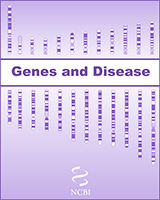NCBI Bookshelf. A service of the National Library of Medicine, National Institutes of Health.
National Center for Biotechnology Information (US). Genes and Disease [Internet]. Bethesda (MD): National Center for Biotechnology Information (US); 1998-.
Hereditary hemochromatosis is an inherited disorder that increases the amount of iron that the body absorbs from the gut. Symptoms are caused by this excess iron being deposited in multiple organs of the body. Most commonly, excess iron in the liver causes cirrhosis, which may develop into liver cancer. Iron deposits in the pancreas can result in diabetes. Similarly, excess iron stores can cause cardiomyopathy, pigmentation of the skin, and arthritis.
Many mutations in the body's iron transport system can cause hemochromatosis; however, most cases are caused by mutations in the HFE gene. This is located on chromosome 6, and one mutation leads to the substitution of the 282nd amino acid. Cysteine becomes tyrosine, therefore the mutation is called C282Y. The switch of amino acids is thought to affect how the HFE protein interacts with the transferrin receptor (TFR1), which plays an important role in iron homeostasis. A less common mutation, H63D, has also been identified in the HFE gene.

The HFE protein
The HFE protein is similar in structure to MHC class I, consisting of two pairs of alpha and beta chains. In the mature HFE protein, the mutation is called C260Y. This is because the body's processing of the protein removes 22 amino acids to produce the (more...)
Hemochromatosis is one of the most common autosomal recessive disorders among Caucasians in the United States; however, only a small proportion of these people suffer any symptoms. This may be attributable to both environmental (diet and blood loss) and genetic factors. Recent advances in the development of animal models that show the complications of hemochromatosis may soon provide useful tools in deciphering how other genes play a part in iron regulation.
Related diseases
- Genome view see gene locations
- Entrez Gene collection of gene-related information
- BLink related sequences in different organisms
- Research articles online full text
- Books online books section
- OMIM catalog of human genes and disorders
- GeneReviews a medical genetics resource
- Hemochromatosis from the National Institute of Diabetes and Digestive and Kidney Diseases (NIDDK), National Institute of Health
- American Hemochromatosis Society information and patient support
- Factsheet from the Centers for Disease Control and Prevention
- Hereditary hemochromatosis - Genes and DiseaseHereditary hemochromatosis - Genes and Disease
Your browsing activity is empty.
Activity recording is turned off.
See more...
